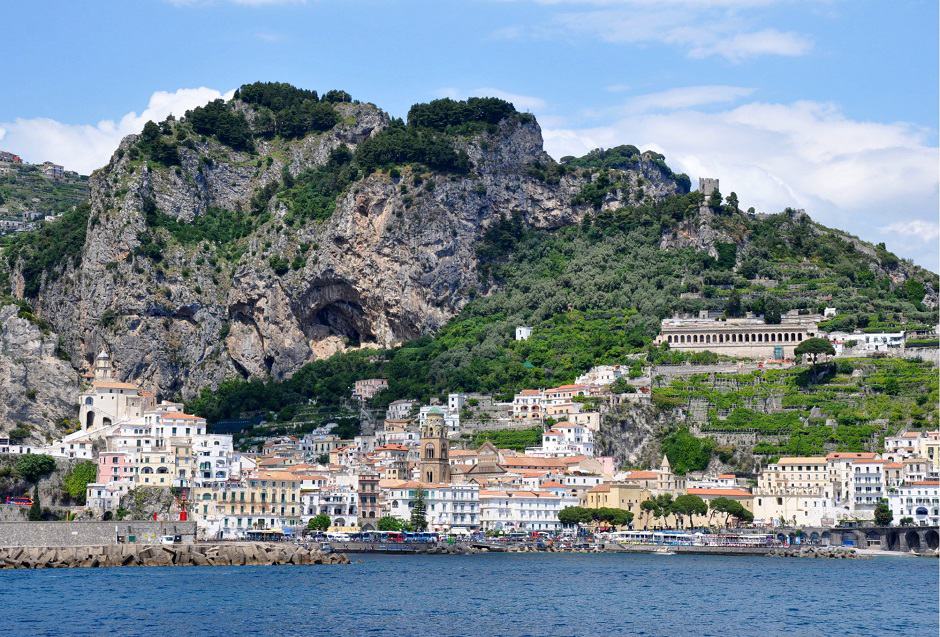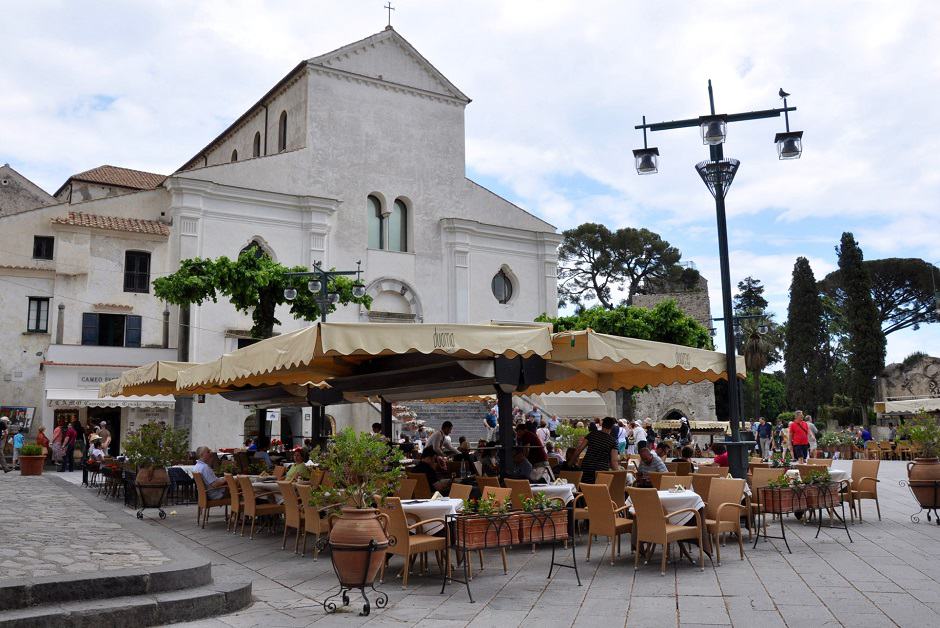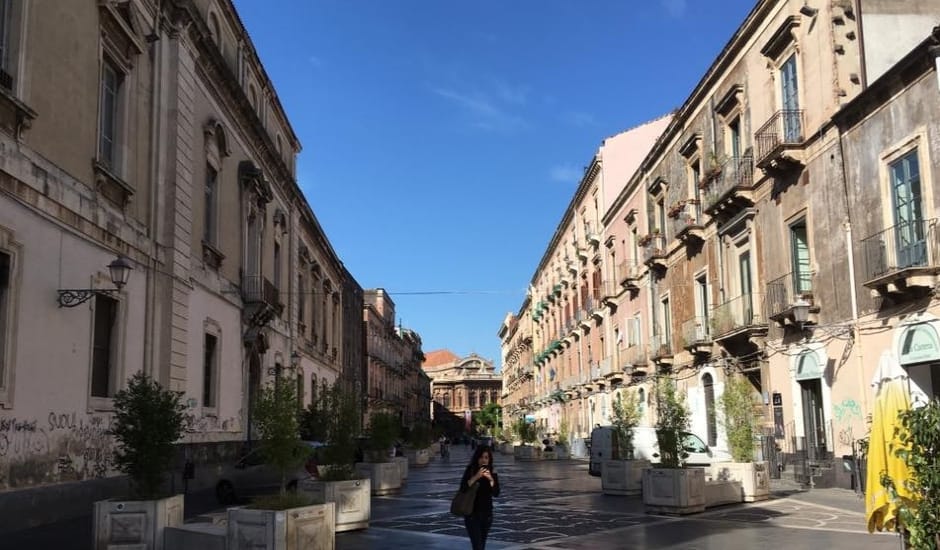Tiny droplets of sea spray prick my cheeks and cling to my glasses. The rain has finally eased though pregnant clouds still blacken the sky. Despite the hit and miss weather, this stretch of the Italian coastline still manages to live up to the high expectations of the many tourists who visit here.
The ferry runs between Positano and Amalfi at regular intervals through the day and this one is packed with people seeking somewhere suitable to savour their lunch.
I’ve travelled down from Rome piecemeal: first the FrecciaRossa train to Naples, then the hot-pink Campania Express to Sorrento, where I’m based. Graced by lemon trees, it’s a pleasant town, but now I’ve reached the Amalfi Coast, I realise it was a warm up act, an ugly duckling to the swan that stretches before me.
The last leg I’ve done by bus, jumping off along the cliff road above Positano from where I descend down an unending flight of steps which I hope will lead me to the beach. By the time I reach the water’s edge, I’ve spent a couple of hours wandering the village’s narrow alleyways, zigzagging my way past budget-busting boutiques and equally expensive restaurants.
Now I’m at sea level. It doesn’t matter that this is not a perfect crescent of soft, white sand. This isn’t the Caribbean. This is Italy, where the coastline is as much about the cliffs as it is the quality of the beach. A shirtless, swarthy youth perches on the concrete of the jetty and tilts his head back to allow the sun to work its magic more evenly. The craggy outcrops in these parts are home to thousands, whose residences somehow manage to defy gravity and cling precariously to the rock, daring the waves to do their worst.
Positano began as a cluster of buildings grouped around a 9th century Benedictine abbey, its population growing with the arrival of those fleeing the Saracens. It was pillaged by Pisa in 1268 – Italy wasn’t a nation state until 1861 – beefing up its defences with thick fortified walls and watch towers in response to stave off later threats.
Here and there, a building stands out from the rest. One such structure is the Chiesa di Santa Maria Assunta, its showy green and gold tiles ensuring that it’s quickly spotted despite the rainbow of colours that forms its backdrop of pastel pink and yellow houses. It’s a seductive scene and I find myself daydreaming I’m in an Audrey Hepburn film, though probably because I eat too much chocolate and I’m an advertising exec’s dream.
The cascade of houses runs out just before the water’s edge, separated from the bay by a grey shingly beach. There’s just time to grab a gelato before the boat leaves. I look at the metal boxes carefully to check they’re real; if the gelato puffs up above the container’s edge, it’s artificial.
Once on board we pick up speed outside Positano’s sheltered harbour and soon the boat is passing the tiny fishing village of Praiano and the cleft in the rocks that marks the fjord of Furore. I’m glad to have my seat on the left side of the boat as those who boarded last are forced to stand on tiptoe to see over our heads.

We continue on past the Grotto dello Smeraldo, named after the emerald green waters that lap the cave. It’s famous all over Italy for the underwater ceramic nativity scene that attracts divers around Christmas time.
After a half an hour or so, the boat slides alongside the jetty in Amalfi’s pretty bay. You could be forgiven for thinking that the plethora of cafes and souvenir shops along the waterfront are reason enough for a visit, but there’s more.
I duck under the alleyway and the most incredible church is revealed in the square behind. Adorned with gilded mosaics and decorated inside with frescoes, it occupies pride of place up a flight of steps directly off the piazza. One thing I notice is the lack of really old buildings; a large earthquake back in the fourteenth century holds the key to the mystery, as the former maritime superpower collapsed and was claimed by the sea. While the church was rebuilt, most other historic buildings were not.
The rain starts again, but on the seafront promenade I manage to find a table under an awning. I take the opportunity to taste some of the fish-based dishes this region is known for: the scialatielli ai frutti di mare combines shrimps, octopus and succulent chunks of fish. By the time I’ve wiped the plate clean, the skies have cleared once more and it’s time to waddle to the bus stop. There’s one last place I’m dying to reach.
Accessed from Amalfi by a switchback mountain road that takes you inland through the Valle del Dragone, the village of Ravello is centred on a pretty square. In the corner sits the Villa Rufolo, its distinctive ageing towers are the backdrop for a beautiful garden designed by a Scot named Francis Neville Reid, in the 19th century.

Opposite, surrounded by pavement cafes is the cathedral, whose interior is worth more than the cursory glance I have time for. A poster lists the concerts that will be staged here over the coming months. Kids play in the dirt and dogs lick their fur clean in between snoozes under shady cafe tables. Italian couples flick cigarette ash and sip espresso, exuding elegance despite their health-ruining habits.
I rue my Englishness. I’ll never be that chic, no matter how long I stay here. And that’s not long: the bus back down to the coast is due to depart soon and the queue is already beginning to snake back through the underpass to breach the square.
Too late, I’ve realised my mistake. This is not the place for a day trip. This is the place for a long, lazy summer.

